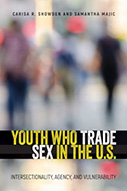Youth Who Trade Sex In The U.S.: Intersectionality, Agency, And Vulnerability

Author: Carisa R. Showden
Publisher: Philadelphia: Temple University Press, 2018. 248p.
Reviewer: Emily van der Meulen | July 2019
In a sea of misinformation, moralism, and exaggerated claims about youth trafficking and sexual exploitation, Carisa R. Showden and Samantha Majic’s Youth Who Trade Sex in the U.S.: Intersectionality, Agency, and Vulnerability is a breath of fresh air. Based on a comprehensive narrative analysis of trafficking research, this book challenges simplistic and reductive notions of young people’s experiences of sexual commerce. Dominant narratives tell a singular, emotive story of exploitation and victimization, almost uniformly lacking an examination of the complex and nuanced realities of marginalized youth, many of whom express and exert agency and self-determination within constrained circumstances. Employing an intersectional approach, Showden and Majic’s well-researched and expertly articulated book presents a more accurate account.
Much of the book’s analysis centers on a critique of what they call the ‘innocent girl-predatory man’ construct, so deeply imbued with racist, classist, and sexist notions. Fundamental to this conceptualization are claims as to the scope and frequency of youth trafficking (with discredited but widely reiterated estimates ranging from 100,000 to 300,000 youth per year in the US). Legislation purporting to combat instances of youth sexual exploitation automatically defines anyone under the age of 18 who trades or sells sex as trafficked; agency, consent, or informed decision-making be damned. As Showden and Majic contend: “The redefinition of young people who trade sex as victims of trafficking is not just an issue of semantics or public policy lacuna–it has become the cornerstone of the dominant narrative about the dynamics of, and people involved in, sex trafficking” (p. 5). These definitional constrains have real implications, often resulting in increased marginalization and criminalization of the very youth the policies aim to ‘protect.’
In an effort to challenge the status quo, Showden and Majic begin their book with a look at the development and ascendance of the unitary trafficking narrative, tracing its origination to the nineteenth century white slavery panics and linking it to contemporary policy debates and priorities. Next, in a chapter co-authored with a graduate student research assistant, they turn to a thorough examination of empirical and methodologically robust (their words) studies on the phenomenon. Here the authors outline their in-depth literature review process and expertly summarize their key results, including analyses of individual, social, and structural factors that shape young people’s experiences in the sex trade. The book’s third chapter draws specifically on their ‘matrix of agency and vulnerability’ as an innovative, intersectional tool for highlighting the complexity of these experiences and realities, while also adding a locational analysis to the factors examined previously. Finally, Showden and Majic conclude by discussing how the application of their matrix framework to future research projects and policy development can lead to social and political improvements for youth who trade or sell sex.
If the goal is to end youth exploitation, then, as Showden and Majic suggest, “it is important to consider not just the media-ready story, but also the stories of a wide range of young people in the sex trades: what are their needs and vulnerabilities? What kinds of policy and community interventions could lessen the exploitation these young people face?” (p. 6, emphasis in original). Therefore, developing an understanding of the diversity of youth experiences, and not glossing these over with a singular narrative, is an invaluable undertaking, one successfully achieved by Showden and Majic.
Emily van der Meulen is an Associate Professor in the Department of Criminology at Ryerson University, Toronto, Canada.


